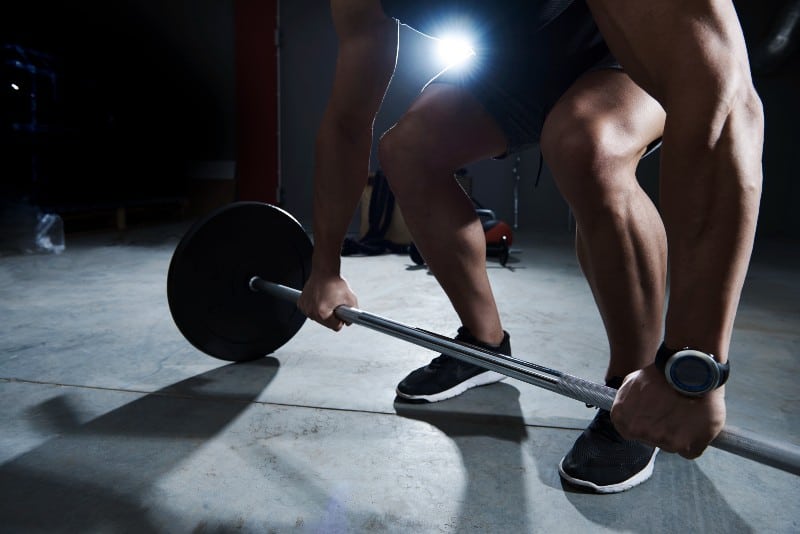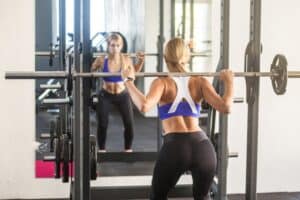Weight training is a fantastic way to improve your muscular endurance, overall strength, fitness, and heart health and boost your bone density. It’s also an incomparable way to build a good natural metabolism (you burn more calories while you’re on an active recovery day if you have more muscle mass!).
However, me telling you the extraordinary benefits of weight training as an experienced personal trainer won’t kick-start a new weight lifting routine if you’ve never stepped foot into a weights room, feel too intimidated to buy a gym membership or have a specific mobility or fitness challenge that means conventional workout programmes aren’t for you.
Let’s pause there and stress the most important point of all. Lifting weights is for everybody. Every size, every age, every fitness level, everybody.
Regardless of whether you’re hoping to find a full body workout to support your blood pressure, want to try out some different exercises to give you fresh fitness motivation, or want to ensure you don’t lose muscle mass as you age, weight training with the proper form is absolutely the right way to go!
How to Start Weight Training as a Beginner
We’ll begin with a quick chat about expectations. Many personal trainers give new clients the impression they’ll be making ridiculous muscle mass gains and transforming their body weight in just a few weeks.
That is possible if you’re already into weight lifting, want to enter a focused, precision-designed weekly weight training schedule, and have some specific goals you’re willing to sacrifice to achieve. However, that’s more of a body transformation programme and isn’t the way to approach a life-long journey to become healthier, fitter and a lot cooler!
As a beginner, your fitness routine should focus on progressive overload. Progressive is the key here; if you expect to be carrying twice your weight over your head in a month, you’ll be sorely disappointed – and that’s an excellent way to injure yourself.
Advice on Weight Training for Beginners
Here are a few of the basics I always concentrate on with clients right from the outset:
-
- Proper form: keeping your legs shoulder width apart for big compound lifts, knowing how to stand tall to complete a rep, and ensuring you create the right muscle tension so that even a short rep scheme is effective and valuable.
- Managing your own body weight: if you’re brand new to resistance training, lifting much heavier weights than you’re used to will cause a lot of delayed onset muscle soreness (the dreaded DOMS). We begin with gradual lifts, reviewing your range of motion and ensuring you’ve got the mobility and flexibility to lift safely.
- Proper technique: done right, the simplest compound movements activate all your muscle fibres and benefit your entire body, rather than one muscle group at a time. Technique is hugely important – if you’ve watched someone deadlift a straining bar with a rounded back, you know what I mean.
Weight training for beginners is all about building those foundations that will set you up for a lifetime of weight training with sound knowledge of the underlying causes of muscle gain.
You need to know how to target those bigger muscle groups that contribute most to your strength and ensure that – whether you keep working with a personal trainer or not – you know how to lift safely and within your abilities.
From someone who has seen it all, it is far better to nail the basics with lighter weights with good form and move onward and upward from there.
What Kit Do You Need to Start a Strength Training Programme?
Avid weight lifters might invest in a whole home gym set-up, resistance bands, barbells, free weights, dumbbells, kettlebells, lifting shoes, lifting belts, chalk, grips – don’t worry, you don’t need any of this stuff.
I’d recommend in-person training with a qualified personal trainer as step one. Gyms will be fully kitted out with all the equipment and machine weights you’ll need, and provided you have clothes you’re comfortable moving in, a pair of trainers and some water, you’ll be ready to begin.
Some personal trainers prefer free weights to machines, but there’s a good place for both. Machines can be a little less focused for those major muscle groups, but they’re also a bit safer if you want to start with gentle resistance training while you increase your range of motion.
Once you’ve had a few sessions of weight training with a certified personal trainer, you’ll know about good form and the correct starting position for each lift and have all-important advice about planning rest days to get the maximum benefit from your strength training.
The Best Strength Exercises for Beginners
Now we’ll run through some top movements to work your entire body and start a consistent strength training plan to increase blood flow to bigger muscle groups, help reduce body fat, and build muscle mass for long-term health gains!
- The Bench Press
The bench press is perfect for upper body strength and is performed lying face up on a workout bench. You can try this with dumbbells, an empty barbell, or a PVC pipe if you’re new to lifting weights – never go too heavy too soon as you can get into a sticky situation!
Keep your shoulders back and your upper body tight, with a slight arch in your back. Engage your core by bracing your stomach muscles for stability and press the bar (or lighter weights) upwards.
You’re aiming for a lift without locking your elbows, so don’t worry about getting your arms straight – they should be roughly shoulder width apart. Rinse and repeat. After a more specific exercise to strength train your chest and arms? Throw in some bicep curls for good measure.
- The Back Squat
Back squats can be great fun and an accessible way to build muscle since you engage certain muscle groups along your posterior chain that have the most power in your body.
Always (always!) begin with lighter weight because as much as strength training can build muscle, you can strain your back and neck if you try to go heavy – exercise slowly until you have a good idea about your ability.
Keep your feet shoulder width apart and turn your toes slightly outward. Pull your shoulders back and down, and squat down – the ideal is to pass below parallel (below your knees), but it’s best to start weight training carefully, so don’t put yourself under too much pressure.
- The Deadlift
Finally, the deadlift is another go-to compound movement that looks a little like a squat, except that you hold the barbell or weights in your hands, with your arms shoulder width apart but gripping the weight from the floor.
You lift with your large muscle groups in your glutes and legs, never your arms or back. Focus on pushing the floor away rather than pulling with your arms, and stand upright. The hips hinge backwards, rather than squat, with a flat neutral spine and shoulders locked back and down.
Strength Training 1-0-1
Those are some of the best movements but are a fraction of the many exercises you can incorporate into a fun, motivating weight training programme!
Remember – start with lighter weights, approach strength training with a positive attitude, and make the most of advice and support from personal trainers who can ensure you start your new plan ready to build yourself stronger, fitter, and healthier every time you step into the gym for your next workout.


